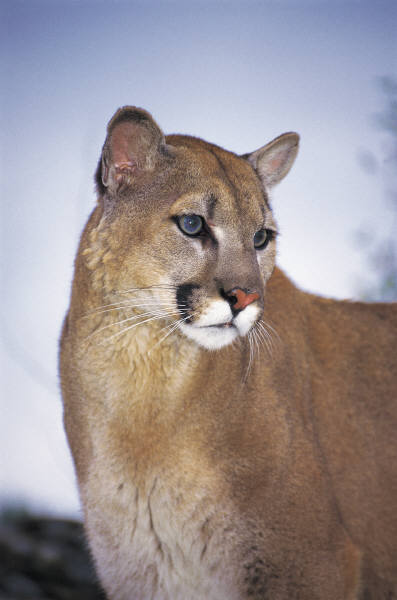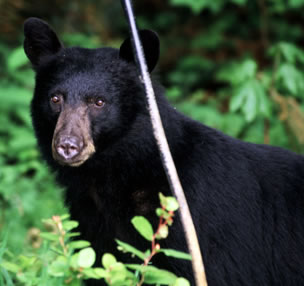Who do the Roosevelt Elk interact with?
The Roosevelt elk associate with many other organisms in its environment that have lead it to live in some interesting ways with those organisms. Not only do wild animals hunt them but humans also do. This is a popular organism that is commonly hunted and used for its meat. The meat is lean and healthy which makes it even more desirable. Not only that but it is sustainable to hunt and there are sometimes quotas put in place so a certain amount of elk are hunted every year to control the population. This is in response to the lack of environmental pressures in certain areas.
When looking at a food pyramid the Roosevelt elk is the primary
consumer. It feeds on the primary producer and is the prey for
secondary consumers and sometimes tertiary consumer. The Roosevelt
elk find themselves attacked by a plethora of predators throughout
their life, especially when they are still young. Here is a list of
major predators the Roosevelt elk face:

Mountain lion, or Cougar.(Puma concolor): The Mountain lion was once a more prevalent predator. When the Europeans began to move into the Mountain lion territory they began to hunt down all of the mountain lions. In 1870 there were still reports of mountain lions in the area. In contrast by 1889 the mere tracks of a Mountain lion became an unusual event(Murie 1967). The population has since gone up to healthy levels but never to the levels seen before the European settlers. The Mountain lion is found in the Olympic mountain ranges to the southern parts of British Columbia. This is also where many Roosevelt elks reside.
Bobcat (Lyxn rufus): The Bobcat's habitat is around the Olympic Mountains. They have been eliminated from most of the other habitats that Roosevelt elk also inhabit. The Bobcat doesn't primarily feed on the elk though. It also feeds on the Snowshoe Hare, the pine squirrel, mountain beaver and field mice (Murie 1967). When the bobcats are not hunting rodents they typically go after elk calves. Usually they target the calves in the spring when the calves are the most vulnerable.
Wolf (Canis lupus): The wolves are the most prolific predator for Roosevelt elk. They are the biggest threat and the largest pressure that the elk face from year to year. The Wolves were eliminated from the Olympic national park system in the 1920's(Murie 1967). With this selective pressure gone the elk population exploded. There were not many pressures that would control the elk population as well as the wolf. With this massive explosion in population the elk began to pillage all of the vegetation that they regularly ate. After a while vegetation was space and the elk population crashed from lack of food. In recent years the wolves have been reintroduced to the Olympic national park. With this there has been more stability within the elk population.
Coyotes (Canis lantrans): The coyote is another prolific hunter that controls the Roosevelt elk population. It primarily eats field mice, pocket gopher, Adult and calf elks, snowshoe hare, marmot, jumping mouse, porcupine, mule deer and muskrat in that order (elk of North America). The coyote lives in all of the habitats that the Roosevelt elk resides in and does commonly hunt them. The coyote primarily eats elk that are weakened by starvation and disease. They can also eat elk that are already dead. Finally coyotes primary prey with elk are the calves that they feast on(Murie 1967).
Domestic dogs (Canis lupis familiaris): The
domestic dogs are dogs that are pets or working dogs that live with
humans. The most damage they usually do is harass the Roosevelt elk
by chasing it around. One of the ways that it will do that is by
running into a field that elk are congregating in. The dog will
scare the elk into starting a stamped. The stampede doesn't usually
involve in any deaths or any harm to the dogs; it is more of just a
shock. The consequences can be more serious when a pack of dogs
actually kill an elk. There have been some reports in which dogs
have attacked and killed elk. This is rare but it should still be noted since it does still happen.
still be noted since it does still happen.
Bears (Ursidae): The bear is a fierce and dangerous predator that will sometimes kill elk. They usually hunt calves and young in the spring and into summer. There have been observers that have seen bear looking for calves in spots that usually contain the young elk(Murie 1967). This means that the bears were actively hunting for young elks so they are more than opportunistic hunters. The bears that typically prey on elk are the grizzly bear and the black bear. The grizzly bear is the only bear that is known to take on adult elks and win. Surprisingly the polar bear is not on this list. There are not any known elk that have succumbed to a polar bear, even though polar bears have been known to wandering into the Northern parts of the elk's territory.
Not only are there predators that the Roosevelt elk have to face but there are also parasites that they have to go up against. A parasite is an organism that will leech nutrients over a period of time from the elk, usually without killing them. There have been fatalities associated with Roosevelt elk and parasites. Here are some of the parasites that Roosevelt elk have to face in day to day life:
Scabies: Scabies is a reaction that occurs when a mite is crawling around underneath the host's skin and causes an intense amount of scratching. This is more of annoyance than anything else. There have been a handful of recorded deaths because of scabies but when taken into account that the elk was already malnourished and sick it can only be listed as a contributing factor. An interesting bit is that the scabies only affects elk. When an infected elk was with domestic cows the cows did not get infected(Murie 1967). This just shows how hard it is to change hosts for some parasites.
Lice: Lice are organisms that crawl on another considerable larger organism and take a blood meal. They usually then detach and find another host when they are hungry once again. Lice are very prevalent in the elk populations. One of the highest concentrations of lice are in the Olympic Mountains. There was one instance in the Olympic Mountains where a cow was found literally covered in lice. In this instance the lice infection was so severe there were necrotic lesions.
Tapeworms ( Thysanosoma actinoides and Cysticercus tenuicollis): In the Olympic Mountains there was on average 7 in 32 tapeworms on average in the elk(Murie 1967). They were typically found in the fourth stomach or small intestines. They absorb nutrients which does not leave as much for the Roosevelt elk. There was also an instance of a tapeworm that was found to be living in the liver of some of the elk.
Nematodes: The most prevalent nematode that infects the Roosevelt elk is the lung worm. This animal will be ingested by the elk. It will then move to the lungs where they develop into adult lungworms. These lung worms then lay their eggs in the lungs and cause the elk to profusely cough. The elk actually coughs the eggs up and soon digests them releasing them into their feces. Nematodes are not as prevalent as live or tapeworms but they still affect the Roosevelt elk.
Liver Flukes: The liver flukes are only known to be in the area of the Olympic Mountains. They have an occurrence as high as 87% in some areas(Murie 1967). These parasites digest the liver of their host. Sometimes these parasites can be fatal but that is rare.
Many of these parasites and predators control the populations of elk very well. Others are more of an annoyance for the elk than anything else. But all of them are important in keeping the population of the elk under control(Murie 1967).
Back to Reproduction Forward to Facts